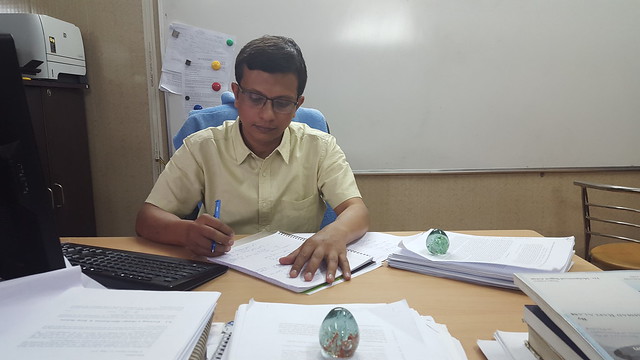By M Reyaz, TwoCircles.net,
Aligarh: Prestigious Aligarh Muslim University has a unique connection to this year’s Nobel winner in Physics. Professor Mohammad Sajjad Athar, a Theoretical Nuclear and Particle Physicist of the Department of Physics of the University, is a collaborator of Japanese Physicist Takaaki Kajita, one of the winners.
Professor Takaaki Kajita is associated with Super-Kamiokande experiment and Professor Arthur B. McDonald is associated with SNO experiment. This year’s Nobel Prize in Physics has been jointly awarded to them for their gigantic efforts made in the last two decades.

Professor Mohammad Sajjad Athar at his Office in AMU
Prof. Sajjad Athar, who mainly works in the area of Neutrino Physics, visited University of Tokyo in May-June 2008 and June-July 2012 on the invitation of Professor T. Kajita and worked on the predictions of Atmospheric Neutrino Flux.
These predictions have been made not only for the ongoing experiments with atmospheric neutrinos at Super-Kamiokande but also for the proposed experiments at South Pole, India Neutrino Observatory, Pyhäsalmi mines, Finland, etc, Dr Sajjad told TwoCircles.net. They have used 400 high speed processors continuously for two yrs to make these predictions.
The outcomes of their collaborative works have been published in three reputed journals, namely Physics Letters B 718 (2013), Physical Review D 92, 023004 (2015) and Proceedings of International Cosmic Ray Conference ICRC 2013.
Originally from Bihar, Professor Athar is also an alumnus of the AMU and recipient of several fellowships. He is a member of NuSTEC (Neutrino Scattering Theory Experiment Collaboration), a group of 25 theoretical and experimental scientists from all over the world who have formed a board and the goal is to reach a consensus on the understanding of neutrino interactions. From Asia there are three scientists, the other two are from Japan.
He is also a member of India-based neutrino observatory (INO) – collaboration, a mega science project, approved by the Govt. of India and Deep Underground Neutrino Experiment (DUNE) Collaboration, Fermi Lab USA.
Professor Athar has published around 60 papers in journals and 50 papers in the conferences. He also gave lectures at the University of Tokyo on the understanding of neutrino interactions with nuclear targets. His calculations are being incorporated in a most reputed Monte Carlo generator named GENIE (Scientists from USA, Europe and Japan) being used in the prediction of neutrino event rates at the various neutrino laboratories including Super-Kamiokande.
In November 2015, he has again been invited to give a series of lectures at the University of Okayama, Japan on the understanding of Neutrino interactions.
When TwoCircles.net asked him to explain for general readers about the nature of his work, Professor Athar said, “Since time immemorial scientists are inquisitive to know the building blocks of the Universe. What are the fundamental objects with which our Universe has been made and what are their properties? Presently in the Standard Model of Particle Physics, neutrino is a fundamental particle like electron, positron, etc., while proton, neutron, etc. are made of another set of fundamental particles known as quarks. Neutrinos come in three flavours viz. electron type, muon type and tauon type and corresponding to each one of them there is an antiparticle.”
“Neutrino is the most abundant particle after photons but little understood as it is weakly interacting. For every proton, neutron and electron, the Universe contains a billion neutrinos. Without neutrinos, there would be no shine in the Sun and stars, no atoms complicated than hydrogen, no carbon, no oxygen, no water, no Sun, no Moon, and no lives,” he explained further.
“It is hence very important to understand this elusive particle,” he told TCN, adding, “Worldwide efforts are going on since the last four-five decades to understand this particle.”
Neutrinos come from the Sun, from the other stars, from the core of the earth where there are radioactive nuclei, from the secondary cosmic ray interaction in the atmosphere constituting atmospheric neutrinos, relic neutrinos present all around us which is like cosmic microwave background radiation confirming that Universe evolved due to Big Bang that occurred about 13.7 billion years ago, and there are many other sources of neutrinos.
